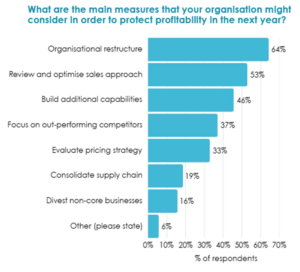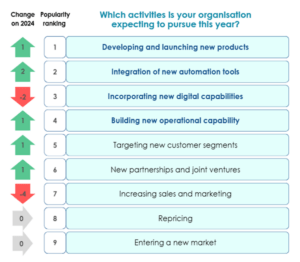As we step into 2025, businesses are seeking effective B2B growth strategies to navigate a complex landscape shaped by lingering macroeconomic challenges, evolving legislation, and rapid technological advancements. While resilience will be a top priority in 2025, companies are also focusing on innovation and strategic expansion to unlock growth. Based on findings from White Space Strategy’s 2025 Growth Outlook, this blog explores three key trends shaping B2B growth strategies in 2025 and outlines actionable steps businesses can take to thrive this year.
B2B Growth Strategies 2025: Resilience is Growth
In 2025, resilience is no longer just about retrenchment—it is intrinsically linked to growth. According to the 2025 Growth Outlook report, two-thirds of business leaders have made building greater resilience a top priority this year. At the same time, 60% of respondents identified business growth as their primary focus for 2025. This combined approach reflects a clear trend: businesses are increasingly leveraging traditional growth strategies as a pathway to achieving resilience.

Organisational restructuring remains a key tool for building resilience in 2025, with 64% of respondents identifying this as a priority. For many businesses, this means a focus on streamlining processes, cutting investment in speculative growth areas and reallocating resources to high-impact areas.
Beyond this however, over half of the surveyed organisations plan to optimise their sales and pricing strategies to protect margins in a competitive market. Building new capabilities is another critical focus, with 46% of businesses prioritising this, and 37% focused on out-performing competitors. These measures are not just about survival—they are about creating a leaner, more adaptable organisation capable of thriving in uncertain conditions.
For businesses, the message is clear: simply battening down the hatches to weather the storm is no longer enough. Instead, resilience in 2025 comes from evolution—adding new capabilities, sharpening competitive edges, and refining propositions. Companies are expected to invest in upskilling teams, adopting digital tools to streamline operations, and enhancing their offerings to outpace competitors. By prioritising expansion, businesses can safeguard profitability against short-term shocks while building a strong foundation for long-term success.
B2B Growth Strategies 2025: Innovation for Competitive Advantage
Innovation remains a critical pillar for B2B growth strategies in 2025, with businesses focusing on product development, digital upgrades and automation to capture emerging opportunities. The report identifies developing and launching new products as the top priority for growth in the short-term, as businesses aim to target fast-growing market niches and diversify revenue streams.

Incorporating digital capabilities and automation will also be a focus for many organisations, as they seek to streamline operations, reduce costs and enhance their value propositions. Despite slightly falling in popularity this year, these technologies are sought out to improve efficiency and enable companies to deliver more personalised and experiential offerings to customers.
Investing in sales and marketing activities has seen as dramatic fall-off in importance compared to last year. This demonstrates the re-organisation of businesses’ investment priorities. With an increased scrutiny on spending, investing in tangible product, service and operational enhancements is the name of the game for 2025.
To capitalise on the innovation opportunities businesses are striving for, adopting a customer-centric approach and using data-driven insights to ensure the understanding of customer needs and competitive dynamics are up-to-date will be critical to tailoring offerings appropriately.
B2B Growth Strategies 2025: Rebound of M&A
M&A is set to play a pivotal role in B2B growth strategies in 2025, as businesses look to outpace competitors and expand into new markets. After a slowdown in 2023, and early signs of improvement in 2024, the 2025 Growth Outlook report predicts a further rebound in M&A activity this year, with both corporates and private equity firms leveraging acquisitions to gain market share and diversify their offerings. This trend is particularly pronounced in stagnant markets, where organic growth opportunities remain limited.
“The 2024 rise in UK deal volume was amplified by a lacklustre 2023, but there are reasons for cautious optimism in 2025. High volumes of dry powder remain, as does a backlog of long-held assets potentially coming to market if macroeconomic conditions and fundraising improve as forecasted”
Global Head of Transaction Advisory, Palladium Digital
Diversification is a key driver of M&A, with 60% of respondents citing the desire to enter new product categories as a primary M&A motivator. Acquiring new technological capabilities, new customer groups and accessing untapped geographies are also high priorities, with nearly half of businesses aiming to use M&A as a tool to access growing markets segments.
Strategic expansion through M&A outside existing markets and product categories demands a carefully structured approach, beginning with identifying markets that offer strong growth and margin potential, followed by narrowing down high-potential acquisition targets. Success in this area requires confidence backed by robust data.
Conclusion: Thriving with B2B Growth Strategies in 2025
The B2B growth landscape in 2025 is defined by a delicate balance between resilience, innovation, and strategic expansion. Businesses that succeed will be those that build resilience through expansion, invest in innovation to capture new opportunities and leverage M&A to accelerate growth. As the 2025 Growth Outlook report emphasises, a clear understanding of customer needs, market drivers, and competitive threats will be critical for navigating the year ahead. By adopting these B2B growth strategies for 2025, companies can not only weather the challenges of 2025 but also position themselves for sustained success in the years to come.


